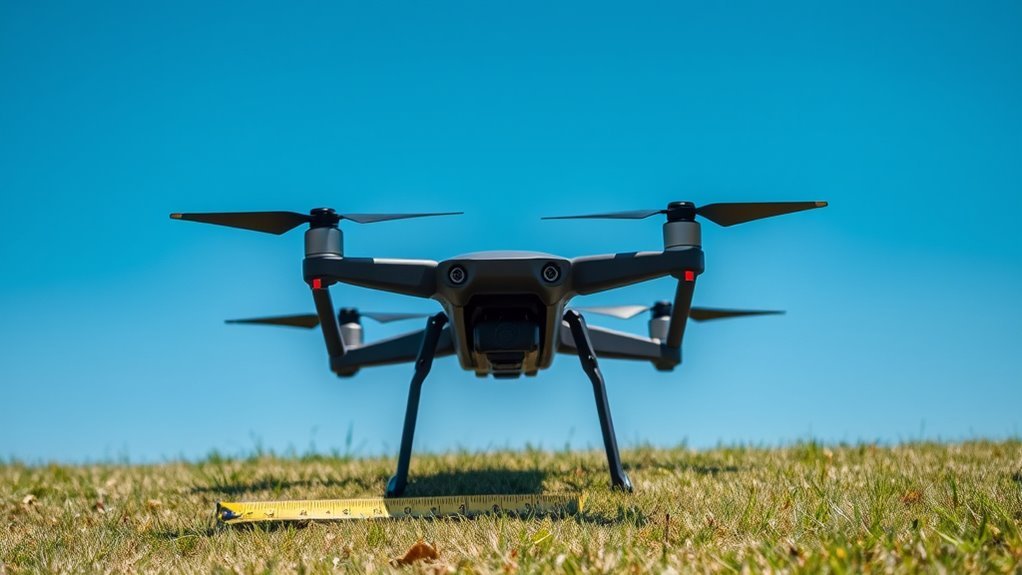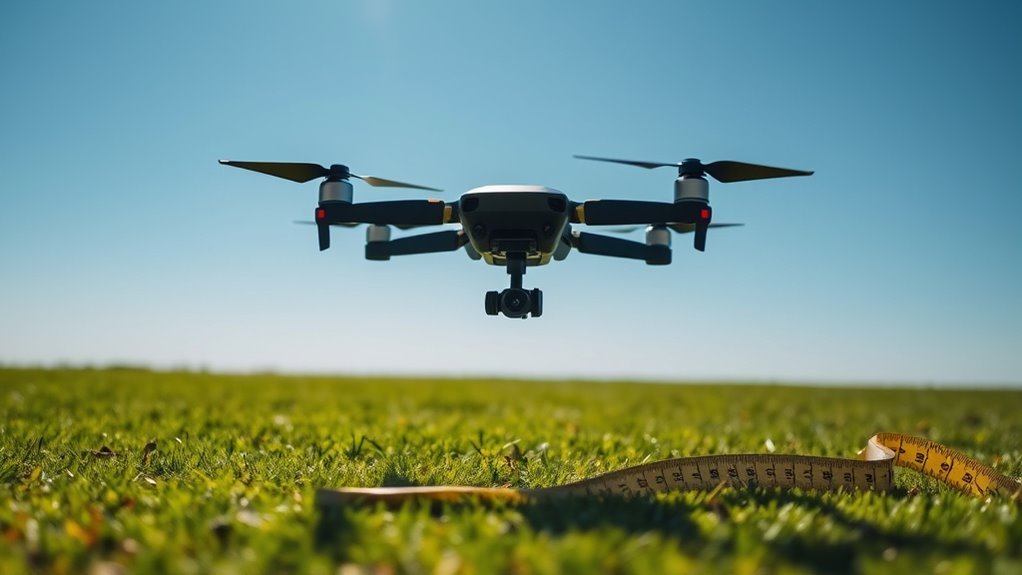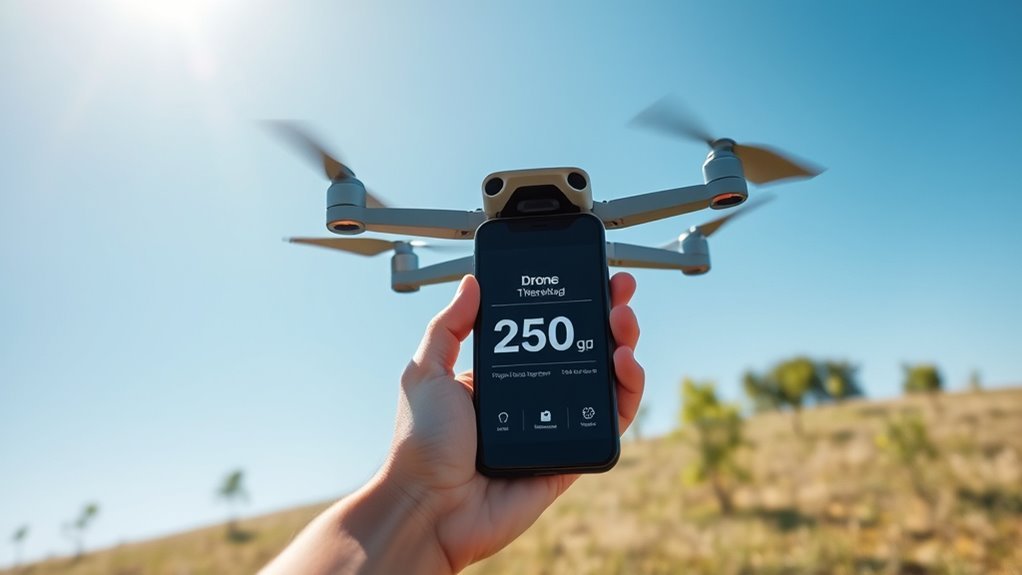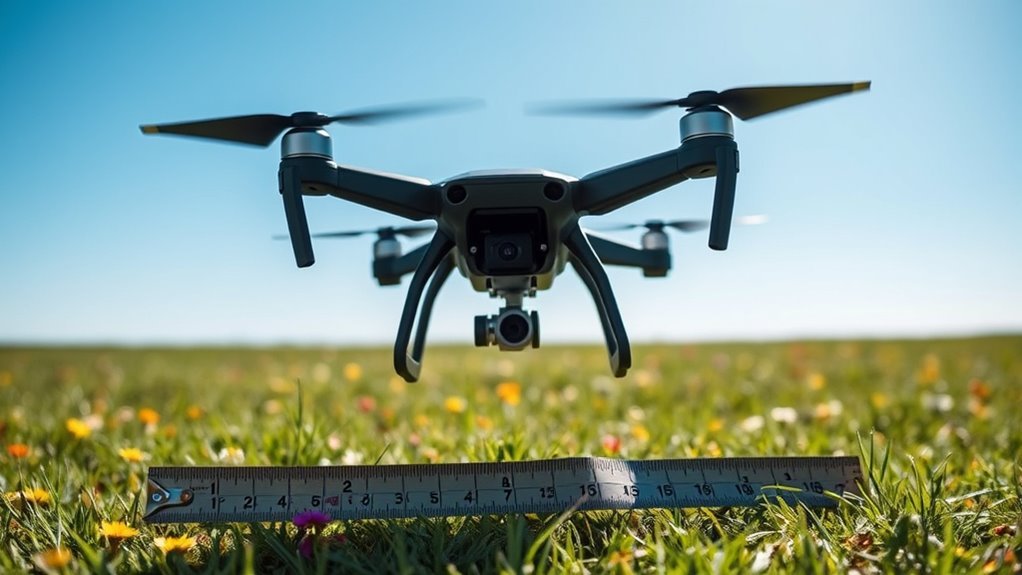If you’re flying a drone that weighs over 0.55 pounds, you must register it with the FAA. Drones under this weight, such as those weighing 250 grams or less, typically don’t need registration and enjoy more operational flexibility. Understanding these weight classifications is essential for compliance and safety. Knowing your drone’s weight can affect your flying experience and legal standing. Continue on to uncover more about the registration process and its implications.
Understanding Drone Registration Requirements

When you’re considering flying a drone, it’s essential to understand the registration requirements that apply to your specific model. Drone regulations vary by country and often depend on the weight and intended use of the drone. For instance, in the U.S., drones weighing over 0.55 pounds must be registered with the FAA. Registering your drone not only complies with legal standards but also offers registration benefits such as ease of recovery if lost, protection against fines, and eligibility for certain airspace permissions. By ensuring your drone is registered, you’re enhancing your freedom to operate while minimizing legal risks. Familiarize yourself with these requirements to fully enjoy the exhilarating experience of flying your drone.
Weight Classifications of Drones

Understanding the weight classifications of drones is essential for compliance with regulatory frameworks, as these classifications directly influence registration requirements and operational limitations. Drones are typically categorized into several weight categories, which serve to distinguish between different drone types. For instance, lightweight drones often fall under the sub-250-gram category, allowing for more flexibility in operation. Conversely, heavier drones may require registration and adherence to stricter regulations. Knowing these weight categories helps you navigate the legal landscape. It’s vital to reflect on how your drone’s weight influences not only registration but also where and how you can fly. By understanding these classifications, you empower yourself to operate within the law while enjoying the freedom that drone flying offers.
The 250-Gram Threshold

The 250-gram threshold marks a significant dividing line in drone regulations. Understanding this 250 gram importance is essential for anyone looking to operate drones legally and freely. If your drone weighs 250 grams or more, you’ll need to register it with the relevant authorities, bringing registration implications into play. This requirement can affect your operational flexibility and limit where and how you can fly. Drones that weigh less than this threshold, however, often escape such regulatory burdens, allowing you more freedom to explore and innovate. By knowing your drone’s weight and its classification, you can make informed decisions that align with your desire for autonomy while ensuring compliance with existing laws.
Drones Weighing Over 0.55 Pounds
Drones weighing over 0.55 pounds (approximately 250 grams) fall under more stringent regulatory requirements, necessitating registration with aviation authorities. Understanding these registration guidelines is essential for maintaining your freedom to operate in the skies. When your drone weight exceeds this threshold, you must register it before any flight, guaranteeing compliance with safety protocols. This registration process involves providing information about your drone, including its specifications and intended use. Additionally, maintaining visual line of sight with your drone is crucial to ensure safe operations. Failure to register can result in penalties, affecting your ability to enjoy aerial activities. By adhering to these regulations, you’re not only safeguarding your freedom but also contributing to a culture of responsible drone operation. Additionally, registration helps authorities track drones in case of incidents. Stay informed and make sure your drone remains within the legal framework to fully experience the benefits of flight.
Exceptions to the Registration Rule
While most drones over 0.55 pounds require registration, certain weight limit exemptions may apply. If you’re using your drone solely for recreational purposes, you might also qualify for specific guidelines that bypass registration requirements. Understanding these exceptions can help you navigate the regulatory landscape more effectively.
Weight Limit Exemptions
Understanding weight limit exemptions is essential for operators who want to avoid unnecessary registration. Drones weighing less than 0.55 pounds (250 grams) are typically exempt from registration criteria established by the FAA. This exemption allows you to operate freely without the burden of paperwork, fostering creativity and exploration. However, verify that your drone complies with this weight threshold; exceeding it necessitates registration, regardless of your intended use. Additionally, certain specific types of drones, such as those used exclusively for educational purposes or research, may also qualify for exemptions. Stay informed about the nuances of these weight limit exemptions to maximize your operational freedom while adhering to regulations designed to guarantee safety in the airspace.
Recreational Use Guidelines
When operating a drone for recreational purposes, you might find some exceptions to the registration rule that can simplify your experience. For drone enthusiasts engaging in recreational flying, consider these guidelines:
- Weight Limit: Drones weighing less than 0.55 pounds (250 grams) typically don’t require registration, allowing for greater freedom in your flying.
- Club Affiliation: If you’re part of a recognized community-based organization, you may benefit from certain exemptions while adhering to their safety guidelines.
- Educational Use: If your drone use is strictly for educational purposes and involves no commercial gain, registration may not be necessary.
Understanding these exceptions can enhance your flying experience, giving you the freedom to enjoy your passion without unnecessary restrictions.
Registration Process for Drones
Before you can legally operate your drone, it is essential to navigate the registration process set forth by the Federal Aviation Administration (FAA). The drone registration is mandatory for devices weighing between 0.55 and 55 pounds. To initiate the process, visit the FAA’s website and provide your information, including your name, address, and email. You’ll need to pay a registration fee, typically around $5, which covers a three-year period. Once registered, you’ll receive a unique identifier to label your drone, ensuring compliance with the FAA’s guidelines overview. Familiarizing yourself with these steps not only keeps you within legal boundaries but also empowers you to fully enjoy the freedom of flying your drone responsibly.
Consequences of Flying Unregistered Drones
Flying an unregistered drone can lead to significant legal penalties, including fines and potential criminal charges. Furthermore, operating without registration poses safety risks, as unregulated drones may endanger people and property. Understanding these consequences is essential for responsible drone operation.
Legal Penalties Incurred
Although the allure of drone operation can be enticing, failing to register your drone can lead to significant legal penalties. Ignoring registration not only jeopardizes your freedom to fly but also exposes you to severe legal ramifications.
Here’s what you might face:
- Fines: You could incur financial penalties of up to $27,000 for repeated violations, impacting your wallet severely.
- Civil Liability: If your unregistered drone causes damage or injury, you could be held liable, leading to costly lawsuits.
- Criminal Charges: In extreme cases, you may face criminal charges, which could result in a permanent record affecting future opportunities.
Being aware of these potential consequences can help you make informed choices about your drone operations and maintain your freedom.
Safety Risks Present
Operating an unregistered drone not only brings legal penalties but also introduces significant safety risks. Ignoring safety guidelines can lead to dangerous drone accidents, potentially harming people, property, or even other aircraft. By bypassing registration, you’re more likely to operate without essential knowledge of airspace restrictions and operational limitations, increasing the likelihood of mishaps.
| Risk Type | Potential Consequences | Prevention Measure |
|---|---|---|
| Collisions | Injury or fatalities | Follow airspace safety guidelines |
| Property Damage | Costly lawsuits | guarantee proper registration |
| Regulatory Fines | Financial penalties | Stay informed on drone laws |
Stay free by flying responsibly; registration is a step toward safer skies for everyone.
Tips for Safe and Legal Drone Operation
Guaranteeing safe and legal drone operation requires adherence to specific guidelines and regulations that govern the use of unmanned aerial vehicles. To maintain drone safety and legal compliance, consider the following tips:
- Know the Rules: Familiarize yourself with local regulations, including no-fly zones, altitude limits, and registration requirements for your drone size. Additionally, make sure to understand the designated areas for drone operation to avoid potential violations.
- Conduct Pre-Flight Checks: Inspect your drone for any mechanical issues, check battery levels, and ascertain that your GPS and other systems are functioning properly before every flight.
- Maintain Visual Line of Sight: Always keep your drone within your visual line of sight. This practice minimizes risks and helps you maintain awareness of your surroundings. Additionally, remember that registration is required for drones over 0.55 pounds to ensure legal compliance and safety.
Frequently Asked Questions
Can I Fly My Registered Drone Internationally?
Yes, you can fly your registered drone internationally, but you must comply with each country’s specific international drone regulations. Researching local laws before flying drones abroad guarantees you avoid legal issues and enjoy a seamless experience.
How Long Does the Registration Last?
Your drone registration lasts for three years. After that, you’ll need to complete the renewal process to maintain compliance. Staying aware of registration duration guarantees you can continue flying freely without interruptions.
What Happens if I Lose My Registration Number?
If you misplace your registration number, you might face registration consequences. Exploring tracking options can help recover it, but guarantee you re-register to maintain compliance and enjoy the freedom your drone offers without complications.
Are There Age Restrictions for Drone Registration?
Yes, there’re age requirements for drone registration. You must be at least 13 years old to register a drone with the FAA. This guarantees responsible ownership and compliance with regulations for safer skies.
Can I Operate Multiple Drones Under One Registration?
You can’t operate multiple drones under one registration. Each drone requires individual registration, ensuring compliance with regulations. The registration process is straightforward but essential for maintaining your freedom to fly without legal complications.

